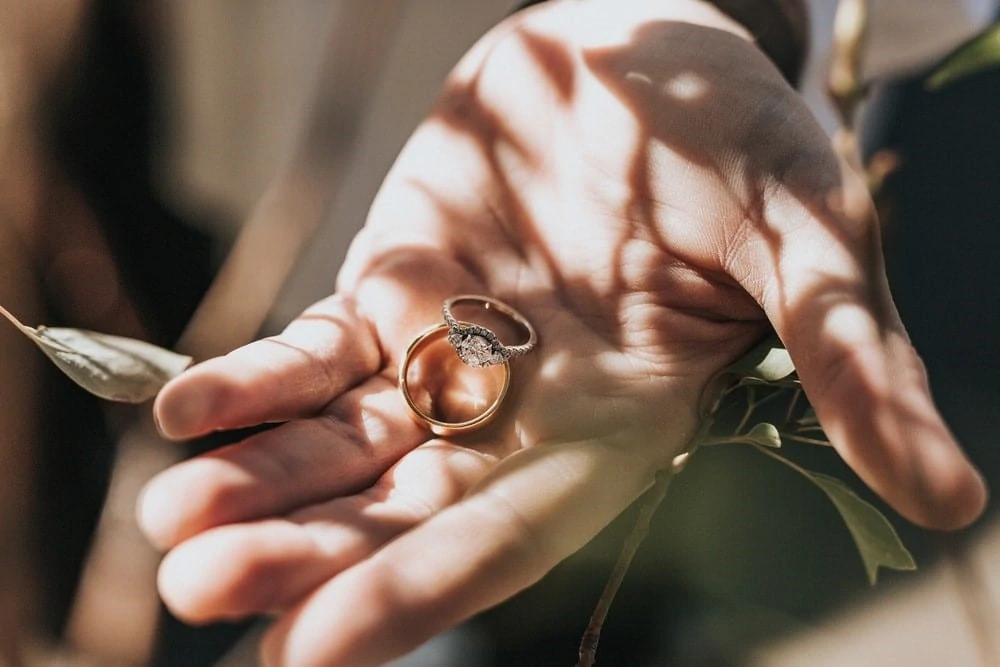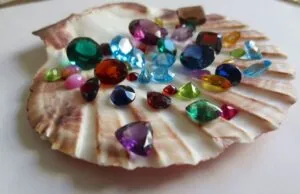
Table of Contents
As Jewelry Shopping Guide editors, we write about things that we love and we think you’ll like too. We often have affiliate partnerships, and may generate some revenue from these links at no cost to you.
If you own gold jewelry or if you’ve started browsing your local jewelry stores, you may have noticed some small numbers engraved in each gold piece. Of these, the most common are 750, 585, and 417.
What do these numbers mean?
Gold Stamps
Most people usually assume that these stamps indicate some sort of manufacturer or a country of origin. However, this isn’t correct.
These numbers are used to indicate the gold’s purity. They are usually referred to as the gold’s “fineness” and they are related to and calculated off the gold’s karats.
These numbers can tell you quite a bit about the gold you’re purchasing and experienced gold buyers know how to read them and how to make the most out of their purchases.
How Is Gold Purity Measured?
Most people know of gold karats as the standard measure for gold purity. 24 karats or 24K means 99.9% pure gold. The lower the karat is, the less pure the gold is.
Do note that while the “more is good” principle typically applies value-wise, 24K gold isn’t actually practical for jewelry. The reason here is that gold, by itself, is too soft for jewelry and it scratches, dents, and breaks too easily. So, instead, 18K and 14K gold alloys are preferred for most quality gold jewelry.
Lower karats are also often used, but anything below 14K is usually made because it’s cheaper and not because it’s harder. 18K and 14K are the preferred middle-ground between value and practical application.
The numbered stamps on gold we’re talking about are related to gold karats and aren’t meant to replace them as a measuring system – just to add some more detail and nuance.
How Gold Alloys Are Made
Gold can be mixed with several different metals to make it harder and more suitable for jewelry. The usual suspects include zinc, silver, copper, nickel, and others
The difference between these is significant as they can determine the various properties of gold:
- The gold’s color. Jewelry gold is usually seen in yellow, pink, or white color, depending on what it’s been mixed with. More reddish or greener variants are also possible but they are rarer. For example, 18K rose gold is made with 75% gold and 25% copper.
- The gold’s hypoallergenic factors. Some people have allergies to certain gold alloys. For example, some yellow jewelry gold alloys include nickel which is a common allergen for many people.
- The gold’s value. Different metals have different values. Copper, for example, is more valuable than zinc so it stands to reason that a gold/copper alloy would be more expensive than a gold/zinc value. While that is the case, however, the difference isn’t all that significant due to how much more valuable gold is compared to all other metals it’s mixed with.
Gold Karats and Corresponding Stamps
So, if a ring is made of 18K gold, why does it have the number 750 stamped on it? The calculation is simple. Here are a few examples:
What does 750 fineness mean?
18K gold has a purity of 75%, i.e. 75% pure gold and 25% copper. The number 18 is also three-quarters or 75% of the number 24 so it’s easy to understand.
The way we get 750, however, is by dividing 18 (the karatage of the gold we’re looking at) and divide it by 24 – the maximum possible karatage of gold. 18 / 24 = 0.75 or 750 thousandths. So, that’s the number that gets stamped on the gold to identify its purity.
What does 585 fineness mean?
As for 585, this corresponds to 14K gold. That’s because 14 / 24 = 0.583, rounded up to 585 thousandths. You’ll often see this gold karatage stamped as 583 too. The two are not used interchangeably, however, and they do mean two different things.
The reason for the discrepancy here is that, in the US and in some other countries, gold is allowed to be slightly undervalued karat-wise. This means that a 14K gold piece, for example, can actually be only 13.8 karats and still be considered 14K. So, if you see two identical gold rings, one marked as 583 and the other as 585, know that the latter is slightly more valuable than the former.
What does 417 fineness mean?
Similarly, 417 or 416 means that the gold piece you’re looking at is 10 karats pure. That’s because 10 / 24 = 0.416(6) repeating, rounded up to 417 thousandths. Again, 417 gold is slightly purer than 416 but both are generally rounded to 10 karats.
Other popular fineness stamps on gold
There are quite a few other fineness numbers you can see on gold. These are all calculated in the same manner:
| Karatage | Gold purity percentage | Fineness number |
| 8K | 33.3% | 333 |
| 9K | 37.5% | 375 |
| 10K | 41.6+% | 416 or 417 |
| 12K | 50% | 500 |
| 14K | 58.3+% | 583 or 585 |
| 18K | 75% | 750 |
| 22K | 91.6+% | 916 or 917 |
| 24K | 99.99% | 999 |
Why Use Fineness Instead Of Karats?
If the gold’s karatage and its fineness numbers are so closely linked, why bother looking at one when you know the other?
The main purpose of gold’s fineness is to give you a guarantee of what you’re buying or selling. If a jeweler tells you that the ring they are trying to sell you is “High-quality 18K gold!” but it’s stamped with 417, you’ll know that they are lying to you to hike up the price.
Vice versa, if you have some old jewelry you want to sell, checking the fineness stamp can tell you what its karatage is and how much you should sell it for.
Some Other Fineness Stamps Or Other Markings You Might See
If you browse through enough jewelry shops you’ll eventually notice some other numbers here and there that we haven’t mentioned in the table above and that don’t really fit in it.
For example, you can often see gold stamped with the number 925. Based on the above calculations, you may think that this gold is 22.2 karats as 0.925 * 24 = 22.2. However, if you look at its price tag you’ll see that much cheaper than 22K gold (stamped with 916 or 917).
The reason here is that the 925 gold you’re looking at is not real gold – it’s vermeil. That’s really gold-plated sterling silver, often used in jewelry. So, in this case, the 925 stamp indicated the silver’s purity and fineness, not the gold’s. And since sterling silver is 92.5% pure, its number is 925.
Additionally, you should also see some other markings right next to the gold’s fineness stamp. These can include letters and symbols and they usually indicate the origin of the gold or the jewelry, its manufacturer, the year of its production, and so on. These can vary greatly so we can’t possibly go over all of them. If you’re curious about a peculiar marking next to your gold’s fineness stamp, however, you should always be able to Google it.
Wrapping Up
Knowing the stamps on your gold will assist you in understanding its value and purity. Always check for stamps. However, note that different countries may have varying stamps and regulations relating to precious metals. It’s good to do your research prior to purchasing gold, especially when overseas.









